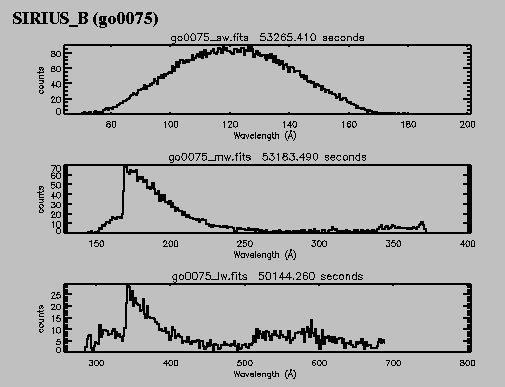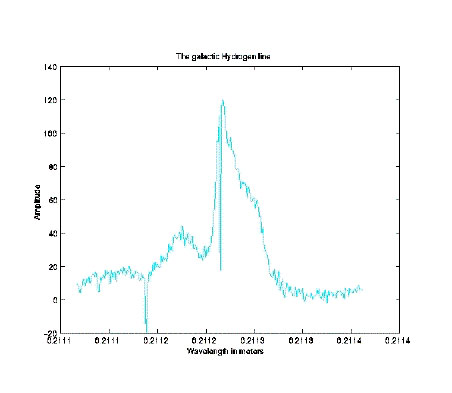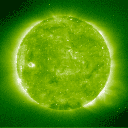 What Kinds of Light are Being Produced from These Objects in Space: O.K., now you've tried your hand at judging the wavelength size of different kinds of light. If you
received a spectrum like the first one below of the white dwarf star Sirius_B would you be able to tell us what kind of light it's producing? Give it a try!
What Kinds of Light are Being Produced from These Objects in Space: O.K., now you've tried your hand at judging the wavelength size of different kinds of light. If you
received a spectrum like the first one below of the white dwarf star Sirius_B would you be able to tell us what kind of light it's producing? Give it a try!
![]() The Spectrum of the White Dwarf Star Sirius_B!
Look at the horizontal axis (the line crossing the bottom of the three
rectangular sections of the spectrum). Do you notice a familiar unit
of measurement? What is the numerical wavelength range covered by
this spectrum? That is, what number does it start at and what number does the spectrum end at. Use the Tool in the Frame Below to figure out what kind of light this is.
The Spectrum of the White Dwarf Star Sirius_B!
Look at the horizontal axis (the line crossing the bottom of the three
rectangular sections of the spectrum). Do you notice a familiar unit
of measurement? What is the numerical wavelength range covered by
this spectrum? That is, what number does it start at and what number does the spectrum end at. Use the Tool in the Frame Below to figure out what kind of light this is.

Here's a more difficult problem!: Try determining the light type of the next spectrum. But, you will need to convert the measurements of the bottom axis from meters to angstroms.
The Galactic Hydrogen Line Spectrum!
What type of light is shown in this spectrum? The spectrum is famous and known as the "21 centimeter hydrogen line." The 21 centimeter hydrogen line spectrum shows a distinctive type of light being produced by hydrogen molecules in space within our Galaxy. Be careful because unlike the last spectrum, this one
has its bottom axis (where you find the wavelength values) measured in meters. So you need to convert these
measurements into angstroms. You might want to know that there are 100 cm in a meter, and .00000001 cm in an angstrom. Give it a try! Use the Tool in the
Frame Below, which works for angstroms, to figure out what kind of light this is.
Can you guess what object(s) in space these images show?

![]() But, Do Objects In Space Produce Only One Type of Light?
But, Do Objects In Space Produce Only One Type of Light?
When you look at the Sun, you are seeing it in visible light. But does it produce other kinds of light as well? Yes, for example, a star like our Sun may be detected in visible light, infrared, X-ray, extreme ultraviolet and ultraviolet light.
An object in our Universe can produce many kinds of light (visible, infrared, gamma ray, etc.) So, it is often useful to look at an object
along the entire electromagnetic spectrum. However, because different light types are recorded by different equipment, scientists often must use several means to record all the different kinds of light produced by one object.
 Objective: Try to Determine the Type of Light Shown in Spectra of Objects in Space
Objective: Try to Determine the Type of Light Shown in Spectra of Objects in Space

 How Do Scientists Record Light Types that are Not Visible to the Human Eye?
How Do Scientists Record Light Types that are Not Visible to the Human Eye? 

